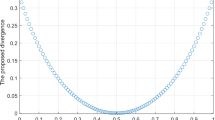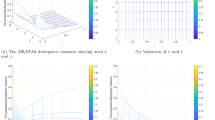Abstract
Dempster-Shafer theory (DST), as a generalization of Bayesian probability theory, is a useful technique for achieving multi-source information fusion under uncertain environments. Nevertheless, when a high degree of conflict exists between pieces of evidence, unreasonable results are often generated using Dempster’s combination rule. How to fuse highly conflicting information is still an open problem. In this study, we first propose an improved belief Hellinger divergence measure, which can fully consider the uncertainty in basic probability assignments, to quantify the conflict level between evidence. Second, some properties (i.e., nonnegativity, nondegeneracy, symmetry, and trigonometric inequality) of the proposed divergence measure are discussed. Then, we present a novel multi-source information fusion strategy, in which the credibility of the evidence is determined based on external discrepancy and internal ambiguity. Additionally, we consider the decay of credibility when fusing evidence across different times. Finally, applications in fault diagnosis and Iris dataset classification are presented to demonstrate the effectiveness of our method. The results indicate that our approach is more reasonable and can identify the target with a higher belief degree.









Similar content being viewed by others
Data Availability
The datasets generated during and/or analysed during the current study are available from the corresponding author on reasonable request.
References
Lin M, Li X, Chen R, Fujita H, Lin J (2022) Picture fuzzy interactional partitioned heronian mean aggregation operators: an application to madm process. Artif Intell Rev 55:1171–1208
Yang X, Chen Y, Fujita H, Liu D, Li T (2022) Mixed data-driven sequential three-way decision via subjective-objective dynamic fusion. Knowl-Based Syst 237:107728
Hua Z, Xue H (2022) A maximum consensus improvement method for group decision making under social network with probabilistic linguistic information. Neural Process Lett 54:437–465
Zhao C, Chang X, Xie T, Fujita H, Wu J Unsupervised anomaly detection based method of risk evaluation for road traffic accident. Appl Intell
Deng Y (2022) Random permutation set. Int J Comput Commun Control 17(1):4542
Fan Y, Ma T, Xiao F (2021) An improved approach to generate generalized basic probability assignment based on fuzzy sets in the open world and its application in multi-source information fusion. Appl Intell 51:3718–3735
Yan Z, Zhao H, Mei X (2022) An improved conflicting-evidence combination method based on the redistribution of the basic probability assignment. Appl Intell 52:4674–4700
Song X, Xiao F Combining time-series evidence: A complex network model based on a visibility graph and belief entropy. Appl Intell
Jing M, Tang Y (2021) A new base basic probability assignment approach for conflict data fusion in the evidence theory. Appl Intell 51:1056–1068
Zhu C, Qin B, Xiao F, Cao Z, Pandey HM (2021) A fuzzy preference-based dempster-shafer evidence theory for decision fusion. Inf Sci 570:306–322
Wang H, Deng X, Jiang W, Geng J (2021) A new belief divergence measure for dempster-shafer theory based on belief and plausibility function and its application in multi-source data fusion. Eng Appl Artif Intell 97:104030
Xiao F (2021) A distance measure for intuitionistic fuzzy sets and its application to pattern classification problems. IEEE Trans Syst Man Cybern : Syst 51(6):3980–3992
Liu R, Fei L, Mi J (2022) An evidential multimoora approach to assessing disaster risk reduction education strategies under a heterogeneous linguistic environment. Int J Disaster Risk Reduction 78:103114
Ma X, Fei Q, Qin H, Li H, Chen W (2021) A new efficient decision making algorithm based on interval-valued fuzzy soft set. Appl Intell 51:3226–3240
Deng X, Jiang W (2019) D number theory based game-theoretic framework in adversarial decision making under a fuzzy environment. Int J Approx Reason 106:194–213
Seiti H, Hafezalkotob A, Herrera-Viedma E (2020) A novel linguistic approach for multi-granular information fusion and decision-making using risk-based linguistic d numbers. Inf Sci 530:43–65
collab=B.Xu, Y.Deng (2022) Information volume of z-number. Inf Sci 608:1617–1631
Tian Y, Mi X, Cui H, Zhang P, Kang B (2021) Using z-number to measure the reliability of new information fusion method and its application in pattern recognition. Appl Soft Comput 111:107658
Diao H, Lu Y, Deng A, Zou L, Li X, Pedrycz W (2022) Convolutional rule inference network based on belief rule-based system using an evidential reasoning approach. Knowl-Based Syst 237:107713
Liao H, Fang R, Yang J-B, Xu D-L (2022) A linguistic belief-based evidential reasoning approach and its application in aiding lung cancer diagnosis. Knowl-Based Syst, pp 109559
Dempster AP (1967) Upper and lower probabilities induced by a multivalued mapping. Ann Math Stat 38(2):325–339
Shafer G (1976) A mathematical theory of evidence. Princeton University Press, Princeton, NJ
Fei L, Wang Y (2022) Demand prediction of emergency materials using case-based reasoning extended by the dempster-shafer theory. Socio Econ Plan Sci, pp 101386
Song Y, Deng Y Entropic explanation of power set. Int J Comput Commun Control 16
Hua Z, Fei L, Xue H (2022) Consensus reaching with dynamic expert credibility under dempster-shafer theory. Inf Sci 610:847–867
Fei L, Feng Y, Wang H (2021) Modeling heterogeneous multi-attribute emergency decision-making with dempster-shafer theory, vol 161
Huang F, Zhang Y, Wang Z, Deng X A novel conflict management method based on uncertainty of evidence and reinforcement learning for multi-sensor information fusion. Entropy 23(9):1222
Dubois D, Prade H (1988) Representation and combination of uncertainty with belief functions and possibility measures. Comput Intell 4(3):244–264
Florea MC, Jousselme A-L, Bossé E, Grenier D (2009) Robust combination rules for evidence theory. Information Fusion 10(2):183–197
Zhao K, Li L, Chen Z, Sun R, Yuan G, Li J (2022) A survey: Optimization and applications of evidence fusion algorithm based on dempster-shafer theory. Appl Soft Comput 124:109075
Xiong L, Su X, Qian H (2021) Conflicting evidence combination from the perspective of networks. Inf Sci 580:408–418
Grzyb J, Klikowski J, Woźniak M (2021) Hellinger distance weighted ensemble for imbalanced data stream classification. J Comput Sci 51:101314
Yager RR (1987) On the dempster-shafer framework and new combination rules. Inf Sci 41 (2):93–137
Ma W, Jiang Y, Luo X (2019) A flexible rule for evidential combination in dempster–shafer theory of evidence. Appl Soft Comput 85:105512
Du Y-W, Zhong J-J (2021) Generalized combination rule for evidential reasoning approach and dempster–shafer theory of evidence. Inf Sci 547:1201–1232
Fang R, Liao H, Mardani A (2022) How to aggregate uncertain and incomplete cognitive evaluation information in lung cancer treatment plan selection? a method based on dempster-shafer theory. Inf Sci 603:222–243
Murphy CK (2000) Combining belief functions when evidence conflicts. Decis Support Syst 29 (1):1–9
Deng Y, Shi W, Zhu Z, Liu Q (2004) Combining belief functions based on distance of evidence. Decis Support Syst 38(3):489–493
Xiao F (2019) Multi-sensor data fusion based on the belief divergence measure of evidences and the belief entropy. Inf Fusion 46:23–32
Fei L, Feng Y (2021) A dynamic framework of multi-attribute decision making under pythagorean fuzzy environment by using dempster-shafer theory. Eng Appl Artif Intell 101:104213
Liu D, Wang S, Tomovic MM, Zhang C (2020) An evidence theory based model fusion method for degradation modeling and statistical analysis. Inf Sci 532:33–60
Deng Y (2020) Uncertainty measure in evidence theory. SCIENCE CHINA Inf Sci 63(11):210201
Zhou Q, Deng Y, Pedrycz W (2022) Information dimension of galton board. Fractals 30 (04):2250079
Xiao F (2020) Efmcdm: Evidential fuzzy multicriteria decision making based on belief entropy. IEEE Trans Fuzzy Syst 28(7):1477–1491
Deng J, Deng Y Maximum entropy of random permutation set, Soft Comput
Hellinger E (1909) Neue begründung der theorie quadratischer formen von unendlichvielen veränderlichen. Journal Fur Die Reine Und Angewandte Mathematik 136:107307
Yaghoubi V, Cheng L, Paepegem WV, Kersemans M (2022) A novel multi-classifier information fusion based on dempster-shafer theory: application to vibration-based fault detection. Struct Health Monit 21(2):596–612
Zhu C, Xiao F (2021) A belief hellinger distance for d-s evidence theory and its application in pattern recognition. Eng Appl Artif Intell 106:104452
Gao X, Pan L, Deng Y (2022) A generalized divergence of information volume and its applications. Eng Appl Artif Intell 108:104584
Chen Y, Tang Y Measuring the uncertainty in the original and negation of evidence using belief entropy for conflict data fusion. Entropy 23(4):402
He Y, Xiao F (2022) A new base function in basic probability assignment for conflict management. Appl Intell 52:4473–4487
Wang Z, Xiao F An improved multi-source data fusion method based on the belief entropy and divergence measure. Entropy 21(6):611
Jiang W, Wei B, Xie C, Zhou D (2016) An evidential sensor fusion method in fault diagnosis. Adv Mech Eng 8(3):1–7
Zhang H, Deng Y (2020) Weighted belief function of sensor data fusion in engine fault diagnosis. Soft Comput 24:2329–2339
Pan L, Deng Y A new belief entropy to measure uncertainty of basic probability assignments based on belief function and plausibility function. Entropy 20(11):842
Yan H, Deng Y (2020) An improved belief entropy in evidence theory. IEEE Access 8:57505–57516
Li J, Pan Q A new belief entropy in dempster-shafer theory based on basic probability assignment and the frame of discernment. Entropy 22(6):691
Qian J, Guo X, Deng Y (2017) A novel method for combining conflicting evidences based on information entropy. Appl Intell 46:876–888
Cortez P, Cerdeira A, Almeida F, Matos T, Reis J (2009) Modeling wine preferences by data mining from physicochemical properties. Decis Support Syst 47(4):547–553
Jiang W, Zhan J, Zhou D, Li X (2016) A method to determine generalized basic probability assignment in the open world. Math Probl Eng, pp 3878634
Author information
Authors and Affiliations
Corresponding author
Additional information
Publisher’s note
Springer Nature remains neutral with regard to jurisdictional claims in published maps and institutional affiliations.
Rights and permissions
Springer Nature or its licensor (e.g. a society or other partner) holds exclusive rights to this article under a publishing agreement with the author(s) or other rightsholder(s); author self-archiving of the accepted manuscript version of this article is solely governed by the terms of such publishing agreement and applicable law.
About this article
Cite this article
Hua, Z., Jing, X. An improved belief Hellinger divergence for Dempster-Shafer theory and its application in multi-source information fusion. Appl Intell 53, 17965–17984 (2023). https://doi.org/10.1007/s10489-022-04428-w
Accepted:
Published:
Issue Date:
DOI: https://doi.org/10.1007/s10489-022-04428-w




